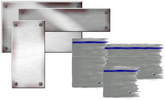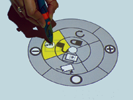







Attribute gates are a new user interface element designed to address the problem of concurrently setting attributes and moving objects between territories on a digital tabletop. Motivated by the notion of task levels in activity theory, and crossing interfaces, attribute gates allow users to operationalize multiple subtasks in one smooth movement. We present two configurations of attribute gates; (1) grid gates which spatially distribute attribute values in a regular grid, and require users to draw trajectories through the attributes; (2) polar gates which distribute attribute values on segments of concentric rings, and require users to align segments when setting attribute combinations. The layout of both configurations was optimised based on targeting and steering laws derived from Fitts' Law. A study compared the use of attribute gates with traditional contextual menus. Users of attribute gates demonstrated both increased performance and higher mutual awareness.